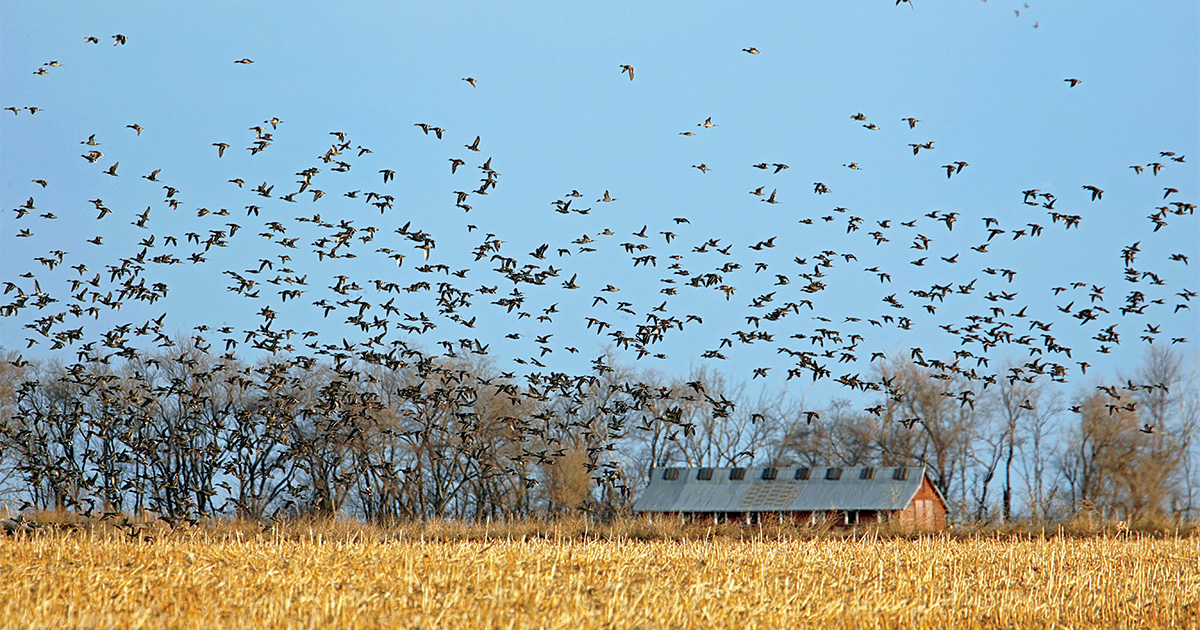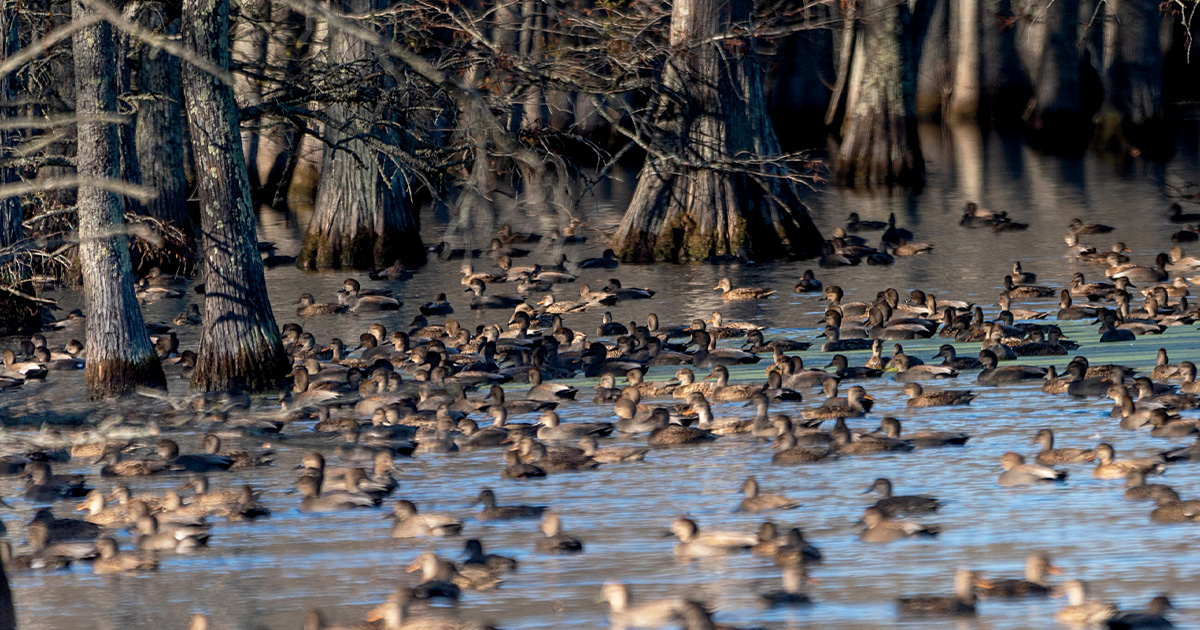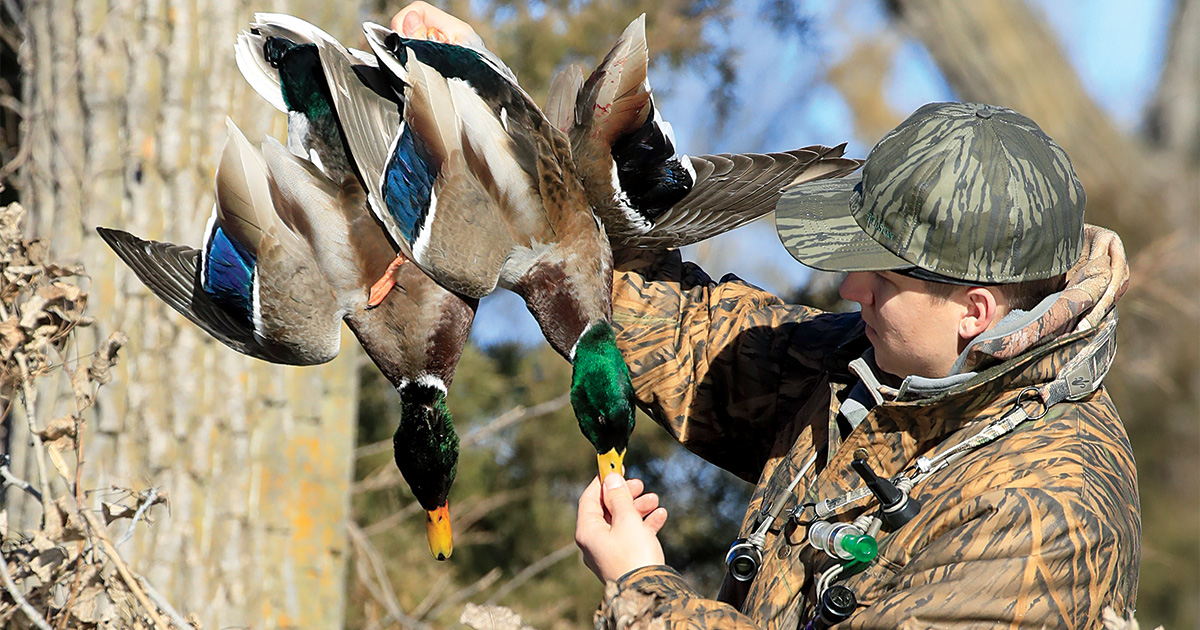Are Waterfowl Distributions Changing?
Recent studies have added to our knowledge about how different environmental factors impact when and where waterfowl migrate and winter
Recent studies have added to our knowledge about how different environmental factors impact when and where waterfowl migrate and winter
By Lisa Webb, PhD, and Mike Brasher, PhD

An ancient Greek philosopher is credited with writing, "You cannot step into the same river twice." Central to this observation is the idea that change is constant for both people and our environment. Many of us would confess that change is what fuels our return to favored marshes, as we seek new experiences and wonder how we too have changed since previous outings.
This is all a rather philosophical way of asking whether we can determine if winter distributions of waterfowl are changing. Can our personal observations account for natural variations in populations, weather, and habitat? How can we tell the difference between an occasional poor season and a larger shift in waterfowl abundance in our hunting areas? As Aldo Leopold, the father of wildlife ecology, put it, "Only the mountain has lived long enough to listen objectively to the howl of the wolf."
When it comes to addressing questions that require a long-term, big-picture perspective, we turn to our own mountain, one built on the collective conclusions drawn from decades of data. However, scientific studies rarely provide a definitive answer to complex questions, and changing distributions of wintering waterfowl are no exception. Nevertheless, it remains valuable to ask and explore what we have learned from recent research. Although waterfowl hunters have been asking questions about changing migration patterns for a long time, science has only recently begun to address them.
One of the first modern studies to examine trends in wintering waterfowl distribution used band recovery and harvest data from 1980 to 2003 in the Mississippi and Central Flyways to determine if the average location of the mallard harvest had changed during that 23-year span. Researchers at the University of Arkansas found that while the average recovery location varied from year to year, there were no large-scale or permanent shifts in mallard harvest distribution. Granted, this study investigated only one species, a cold-tolerant one at that, and since it was completed, we have witnessed different patterns of environmental conditions, including nine of the 10 warmest years on record. What can we learn from other species and more recent years?

Research led by the National Audubon Society used Christmas Bird Count data from 1969 to 2019 to evaluate whether trends in winter duck abundance differed between northern and southern states in the Atlantic and Mississippi Flyways and if those trends were related to average winter temperatures. The study indicated that the relative winter abundance of some species, including American black ducks, American wigeon, mallards, and lesser scaup, generally increased in northern states and decreased in southern states. Additionally, the rate of change was related to winter temperature. States that historically had colder winters experienced greater increases in these species' abundance. The magnitude of these changes, however, was less than 10 percent from one year to the next. Other species such as gadwalls, blue-winged teal, and northern shovelers did not show differences in December abundance trends over this 50-year period. However, a possible limitation of using Christmas Bird Count data in this study is that most of the survey routes are located near cities and towns and may not overlap with areas where ducks congregate in largest numbers.
The question of whether distributions of wintering waterfowl are changing is not limited to North America. Researchers in Europe, led by the Finnish Museum of Natural History, used 30 years of survey data (1980-2010) from nine countries to investigate if changes were occurring in the winter distribution of tufted ducks, goldeneyes, and goosanders. The abundance of all three species increased in the northeastern portions of their historic wintering ranges and decreased in the southwestern parts of their ranges.
Waterfowl managers and hunters are also intrigued by potential changes in the timing of the birds' migrations. Researchers from Colorado State University relied on the novel approach of using weather radar to detect birds in flight to assess the timing of large-scale migrations. Focusing on peak migration dates from individual weather stations across the United States, researchers found that since 1995 peak migrations have occurred earlier, during both fall and spring, likely related to changes in temperatures and other environmental conditions. However, this study was not able to differentiate among bird species, so these results included many birds other than waterfowl.
In a related study, scientists with the Canadian Wildlife Service recently examined this same question by analyzing waterfowl counts from fall surveys along the Great Lakes from 1968 through 2011. Over those 43 years, peak migrations from the region occurred later for four species-mallards (14 days), American black ducks (18 days), American wigeon (13 days), and gadwalls (11 days). Migration timing for blue-winged teal and American green-winged teal did not change during that period. A comparable European study found similar delays in the timing of fall migration for six of 15 waterfowl species studied.

Drawing universal conclusions from these various studies, where trends in migration timing and winter distributions often differ among species and regions, is admittedly challenging. These studies relied on different data (e.g., band recovery, surveys, and weather radar) and time periods to address a common question, so a certain lack of consistency in results is understandable. Differences among species are undoubtedly related to the diverse life histories among waterfowl. For example, because blue-winged teal migrate early, winter farther south, and rely heavily on wetland-based foods, they may not have the behavioral flexibility to respond to warming fall temperatures. Instead, their migration timing is more closely tied to cues such as changing day length. In comparison, species such as mallards and American black ducks are larger bodied, more tolerant of colder temperatures, and exhibit greater flexibility in diet.
Consequently, these species can easily respond to changing weather patterns, and their migration is closely linked to temperature and snow cover.
Due to the many uncertainties mentioned above, we have not yet fully answered whether waterfowl distributions and migrations are changing. It is not clear whether recent observations reflect longer-term patterns, although trends are emerging for some species. Obtaining better answers to these questions is among the highest priorities for waterfowl managers and researchers today, and collaborative analyses and new research projects are under way. Some of these studies rely on novel technologies such as GPS satellite transmitters to track the seasonal movements of individual birds, while others use new and innovative analytical techniques.
Broad scientific conclusions about complex natural phenomena develop incrementally. Each study adds to our body of knowledge, but finding answers often takes longer than we'd like. Eventually, the scientific process accumulates enough evidence to provide a reliable view, allowing us to distinguish between local experiences and larger patterns. Once these are understood, waterfowl managers and conservation groups, such as Ducks Unlimited, will play an important role in communicating what we've learned and the implications for hunters and waterfowl conservation.
Dr. Lisa Webb is a research ecologist with the US Geological Survey and an associate cooperative professor at the University of Missouri. Senior Waterfowl Scientist Dr. Mike Brasher is based at DU national headquarters in Memphis.